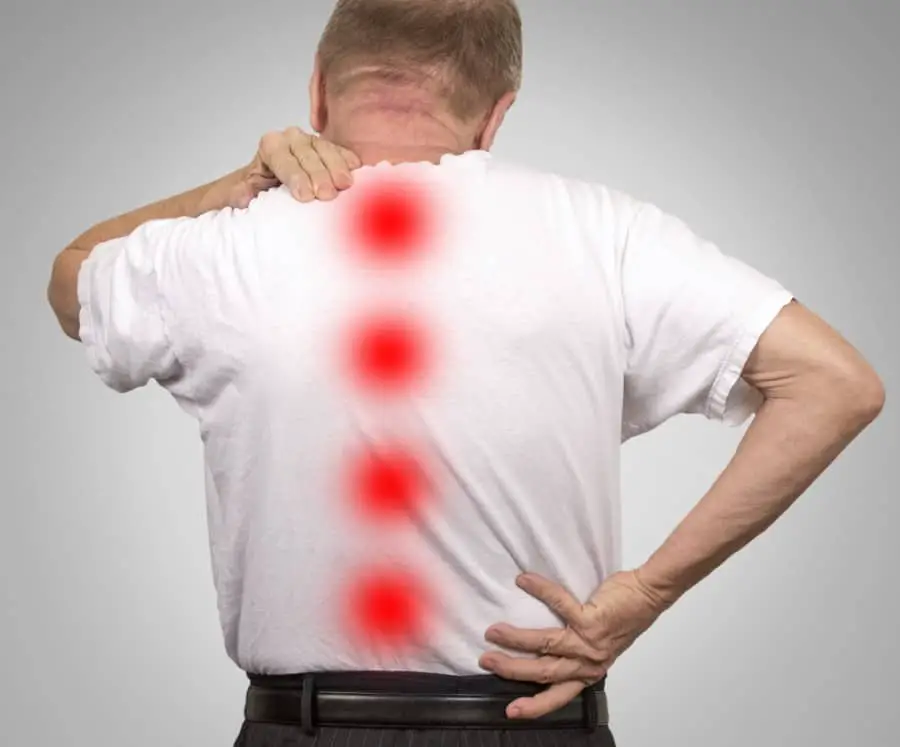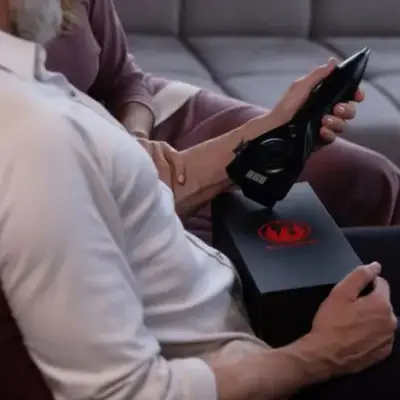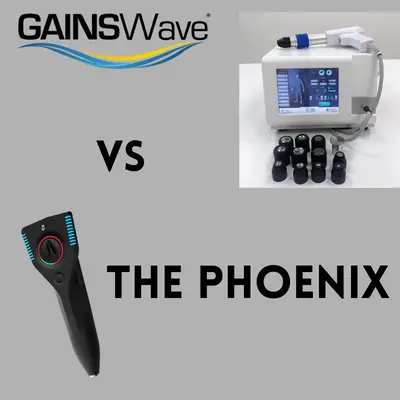Spinal stenosis can be a very debilitating condition of the lower back. This condition can be so severe that it causes intense numbness, tingling, and difficulty walking. The problem is that most treatment for spinal stenosis is daily pain-relieving medication, steroids, or even surgery.
A TENS unit can be good for reducing the pain caused by spinal stenosis when used in the lumbar region of the spine. Other studies have shown that using a TENS unit can improve the ability to walk in those with severe spinal stenosis. But, more severe cases might not improve with a TENS unit.
There’s a good deal of research into both TENS units and spinal stenosis. So, let’s go over exactly what spinal stenosis is. Then, we’ll talk about the potential role the TENS unit plays in treating spinal stenosis and exactly where to place the electrode pads.
What Is Spinal Stenosis?
Spinal stenosis is a relatively common condition that usually occurs in older adults or those with previous back injuries. This condition involves a build-up of pressure within the spinal column, which puts undue stress on the local nerves and spinal cord.
This added pressure on the nerves of the spine sometimes results in tingling sensations, numbness, and weakness across the body.
Spinal stenosis is most commonly seen in the lumbar region of the spine (toward the tailbone). However, it can target the cervical spine (the neck) as well.
Causes
There are quite a few causes of spinal stenosis.
This condition often comes with age, especially as the muscles, joints, and bones continue to weaken. That’s why spinal stenosis is much more common in patients that have been diagnosed with arthritis.
Spinal stenosis might also develop if you have a pre-existing back injury or fracture.
Signs & Symptoms
The symptoms of spinal stenosis depend on whether your lumbar or cervical spine is impacted by this condition. Here’s a look at some of the symptoms you might notice:
- Pain in the lower back or neck
- Weakness, numbness, and tingling in the extremities (hands, feet, arms, and legs)
- Severe lower back pain when in a seated or standing position
- Pain, weakness, numbness, or tingling that radiates from the back to the extremities
If you notice any or all of these symptoms, it’s important that you visit your doctor to receive a proper diagnosis. Your doctor can then discuss possible treatment methods with you.
Common Treatment Methods
There are plenty of proven treatment methods for spinal stenosis. Each one has its own benefits and limitations. Here’s a look at the treatment methods you could pursue post-diagnosis:
- NSAIDs (Nonsteroidal anti-inflammatory drugs). These are your basic over-the-counter pain relievers like Advil, Tylenol, and Aleve. These are extremely useful for mild, nagging, or aching pain caused by spinal stenosis.
- Cortisone Injections. These are steroid injections that are administered directly around the impacted area. They involved a series of shots over the course of a few months and are meant to reduce spinal swelling and pain.
- Opioids. When your spinal stenosis pain is severe, your doctor might prescribe opioids like Vicodin or Oxycontin instead. Though these prescriptions tend to be very effective at reducing pain, they also might be addictive.
- Surgery. In the most severe cases, your doctor might recommend some form of decompression surgery. This type of surgery will help to widen your spinal column and relieve some of the pressure that’s causing your pain, numbness, and weakness.
There are also other treatment methods that can be used to reduce symptoms, though they won’t cure your spinal stenosis. These alternative methods include frequent physical therapy, acupuncture, and heat/cold applications.
There’s also the TENS unit.
TENS Unit Placement for Spinal Stenosis

When placing the TENS electrode pads make sure to never place directly on the spinal cord. Place 2 pads on each side of your spinal cord about one inch apart.
Want to know where a TENS unit can be placed? Check out my TENS placement guide here. Below are a few common TENS electrode pad placements:
Spinal Stenosis Treated With TENS Unit?
The fact that there are tons of treatment methods available for spinal stenosis might sound like a good thing. But, most of these treatment methods are meant for immediate pain relief and hardly produce long-term results.
Here’s why:
- Your body could build up a tolerance to NSAIDs or opioids, meaning you’ll need more and more to continue seeing the same effects.
- Spinal surgery is always expensive, risky, and even a bit frightening.
- Cortisone shots require a series of shots over the course of a few months, and you’ll probably need another round on a yearly basis.
That’s where the TENS unit might just be your saving grace. Let’s check out what the research shows right now.
Improved Walking Ability
The key side effect of spinal stenosis is back, leg, and arm pain. Yet, this condition also comes with weakness, tingling, and numbness. When combined, you might find it difficult to walk for extended periods of time after your diagnosis.
That was the focus of a 2019 study.
Researchers recruited a group of participants that have been impacted by spinal stenosis. Each study group would undergo some form of treatment with a TENS unit to see potential effects regarding walking ability.
The results were remarkable.
Both the active and de-tuned TENS unit groups demonstrated improvement in their walking ability. In fact, most participants were able to walk an additional 160+ meters over the course of the timed walk test.
About 70% of the participants (in total) walked 30% further than normal.
Not only does this show that the TENS unit can improve walking ability in those with spinal stenosis, but it also shows that any way you use this unit will provide benefits.
Possible Pain Reduction
Since chronic lower back pain is such a hot topic in recent years, scientists and researchers alike have sought out alternative treatment methods to alleviate symptoms and signs. Very few studies have analyzed the connection between lower back pain caused by spinal stenosis and pain relief from a TENS unit.
The study we’re about to discuss references lower back pain in general.
In the case of a 2013 review study, a team of researchers took a good look at all the research that has been done regarding the role a TENS unit might play in reducing lower back pain.
Here’s what they learned.
The TENS unit is most effective when used two or more times per week. It has been proven to be effective at reducing nerve pain or pressure in the spinal column.
There is a possibility that using a TENS unit frequently can cause your body to build up a tolerance. That means you’ll need to use your TENS unit at a higher intensity to see the same or better results with time.
Researchers concluded that the best results would occur if you increase the intensity output on your TENS unit by about 10% or more between daily sessions.
Most importantly, very few studies have shown significant pain reduction in those using a TENS unit after a spinal stenosis diagnosis. While there are some advantages in regards to pain relief, you should try other verified treatment methods first before leaning on the TENS unit for support.
The effects that the TENS unit will cause are limited.
Conclusion
Spinal stenosis is a severe condition that requires some form of treatment to make daily life just a little more bearable. Some of the more common treatment methods include NSAIDs, cortisone injections, and even invasive surgery.
A TENS unit might help to improve your condition.
TENS units are known to improve walking ability significantly in those with spinal stenosis. There’s also a possibility that a TENS unit can reduce your spinal stenosis pain. Just keep in mind that the TENS unit won’t cure your spinal stenosis and is only a means of pain relief and improved mobility.
Sources
- NIH: Effect of active TENS versus de-tuned TENS on walking capacity in patients with lumbar spinal stenosis: a randomized controlled trial
- Mayo Clinic: Spinal Stenosis
- Healthline: Spinal Stenosis
- National Institute of Arthritis and Musculoskeletal and Skin Diseases: Spinal Stenosis
- Mayo Clinic: Arthritis
- American Academy of Orthopaedic Surgeons: What are NSAIDS?
- NIH: What Makes Transcutaneous Electrical Nerve Stimulation Work? Making Sense of the Mixed Results in the Clinical Literature





3 responses to “Is TENS Unit Good for Spinal Stenosis?”
[…] penetrate into the body deeply enough to reach medical rods of any kind. It is safe to use a TENS unit on the back after spinal surgery or other procedure that requires titanium or stainless steel rods to be placed in the […]
[…] sciatica, which, again, is most often a herniated disc, but could be other conditions, including spinal stenosis or […]
[…] Gate Control Theory suggests that the electrical impulses emitted by TENS units and devices are strong enough to close the ‘nerve gates’ along the spinal column, resulting in a reduced perception of […]